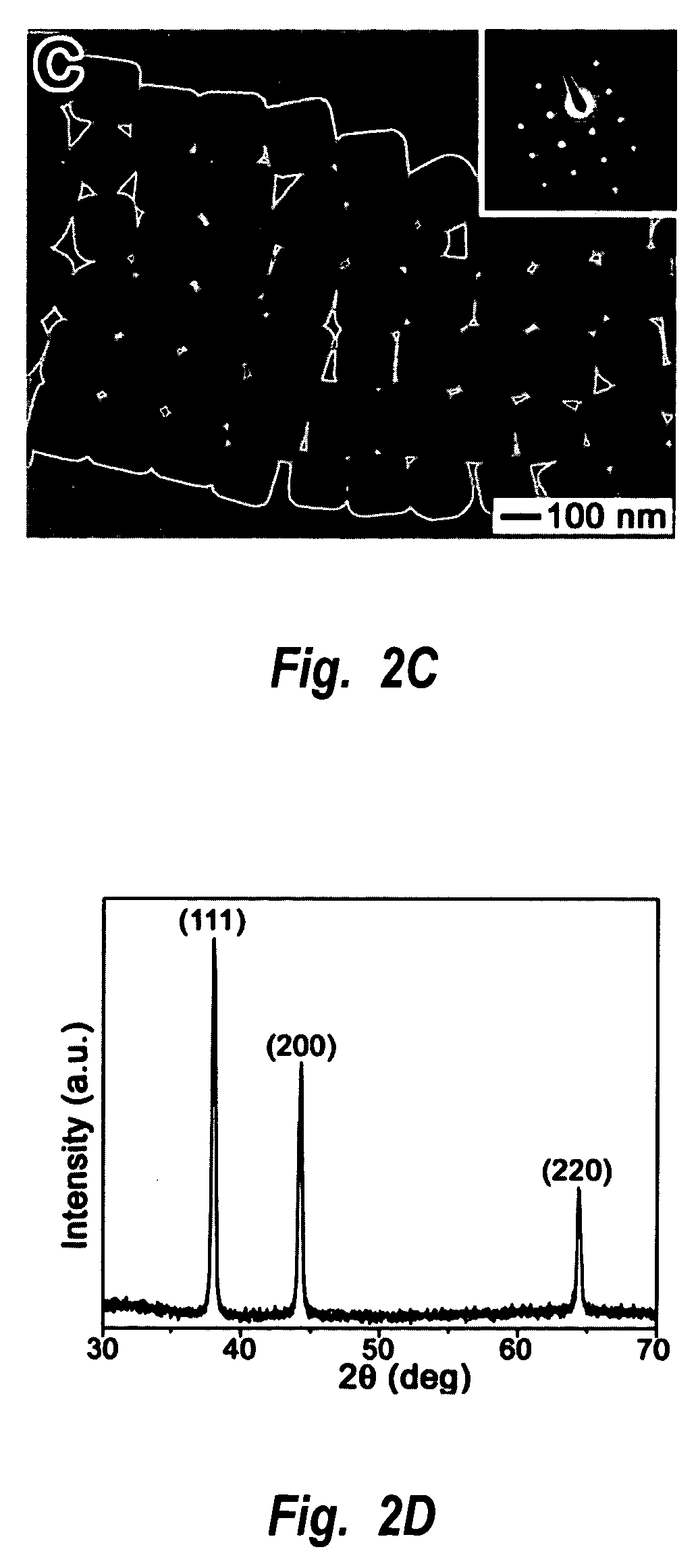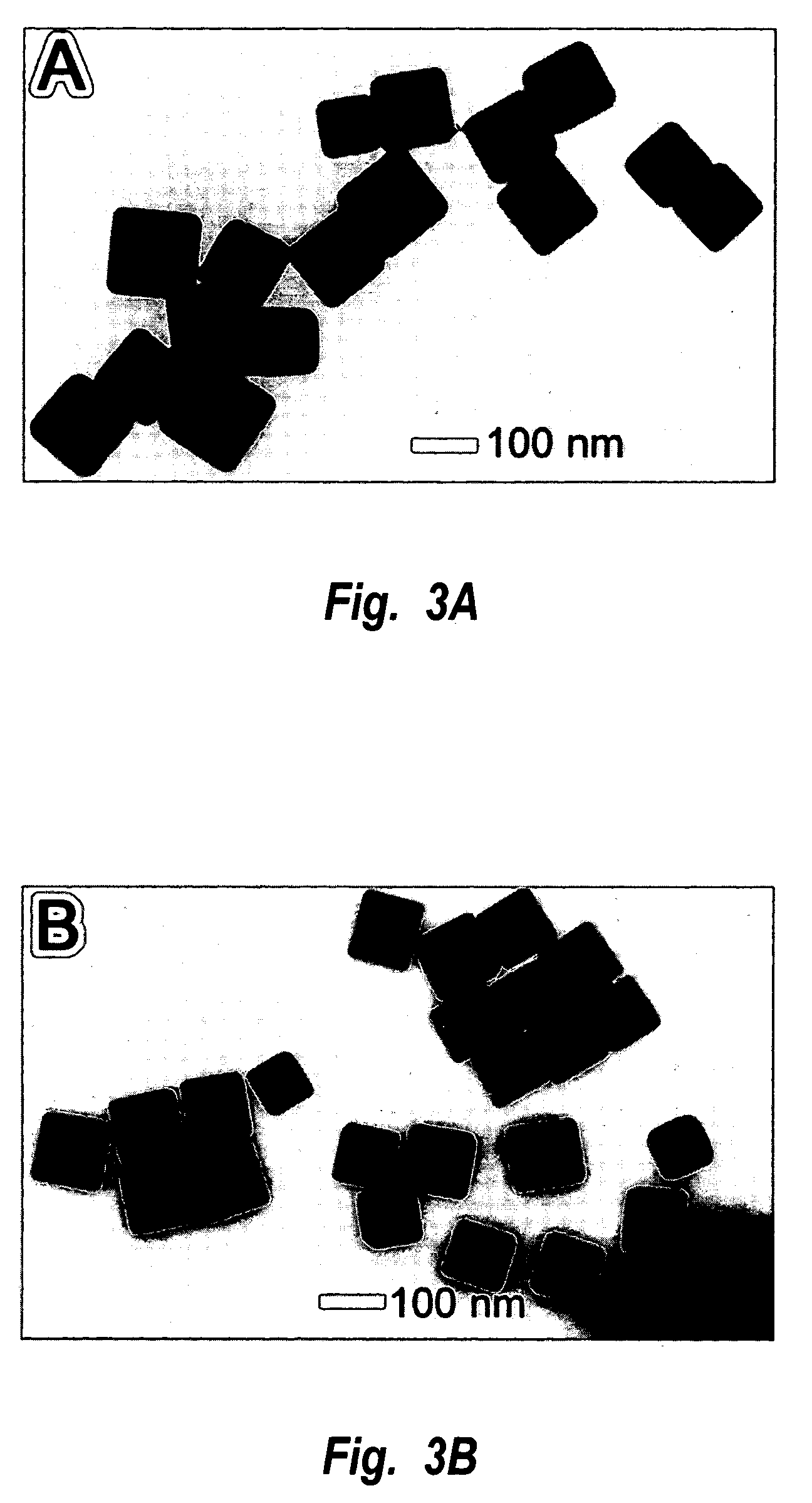Methods of nanostructure formation and shape selection
a nanostructure and shape selection technology, applied in the field of nanostructure formation and shape selection, can solve the problems of limited success in synthetically controlling the shape of metal nanoparticles, and achieve the effect of reducing the number of nanoparticles
- Summary
- Abstract
- Description
- Claims
- Application Information
AI Technical Summary
Problems solved by technology
Method used
Image
Examples
examples 1-4
Formation of Silver Nanostructures
Example 1
example 1
glass flask and condenser are immersed in nitric acid bath (VIV=1:4) for 10 h and rinsed with copious water, then dried in the oven at 60° C. All the other glass stuff, including 20-mL liquid scintillation glass vials and disposable pipets, can be cleaned via the same procedure.
The recipes include silver nitrate (silver source), PVP (shape-selective reagent, weight-average molecular weight ≈55,000), anhydrous ethylene glycol (both solvent and reducing agent, such as the product from Aldrich, Milwaukee, Wis.).
A solution of PVP can be prepared by dissolving appropriate amount of PVP in anhydrous ethylene glycol with the final concentration of 0.375 mol / dm3 (in terms of repeating unit). For the preparation of a solution of silver nitrate, the calculated amount of silver nitrate (milled into fine powder) is added to anhydrous ethylene glycol, then bubbled with air to accelerate the dissolving process. The silver nitrate should be dissolved completely within 1.5 min with final concent...
example 2
Silver nanocubes were prepared by heating 5 mL anhydrous ethylene glycol (99.8%+, Aldrich, Milwaukee, Wis.) in a 100 mL flask (ChemGlass, Vineland, N.J.) at 160° C. for 1 hour. Two solutions were prepared: a 3 mL ethylene glycol solution of silver nitrate (0.25 mol / dm3, 99+% Aldrich) and PVP (0.19 mol / dm3 in terms of repeating unit, Mw≈55,000, Aldrich); and (2) a 3 mL ethylene glycol solution of PVP (0.19 mol / dm3 in terms of repeating unit, Mw≈55,000, Aldrich). The two solutions were simultaneously added to the hot ethylene glycol using a two-channel syringe pump (KDS-200, Stoelting Co., Wood Dale, Ill.) at a rate of 0.375 ml / minute. The reaction mixture was then continued with heating at 160° C. for 40 minutes. Magnetic stirring at a rate of about 400 rpm was maintained through the entire synthesis. The product was dominated by cubic nanoparticles, with a small amount (<5%) of nanostructures with other morphologies (e.g., rods, cubooctahedrons, tetrahedrons, and spheres).
PUM
| Property | Measurement | Unit |
|---|---|---|
| Temperature | aaaaa | aaaaa |
| Temperature | aaaaa | aaaaa |
| Molar density | aaaaa | aaaaa |
Abstract
Description
Claims
Application Information
 Login to View More
Login to View More - R&D
- Intellectual Property
- Life Sciences
- Materials
- Tech Scout
- Unparalleled Data Quality
- Higher Quality Content
- 60% Fewer Hallucinations
Browse by: Latest US Patents, China's latest patents, Technical Efficacy Thesaurus, Application Domain, Technology Topic, Popular Technical Reports.
© 2025 PatSnap. All rights reserved.Legal|Privacy policy|Modern Slavery Act Transparency Statement|Sitemap|About US| Contact US: help@patsnap.com



